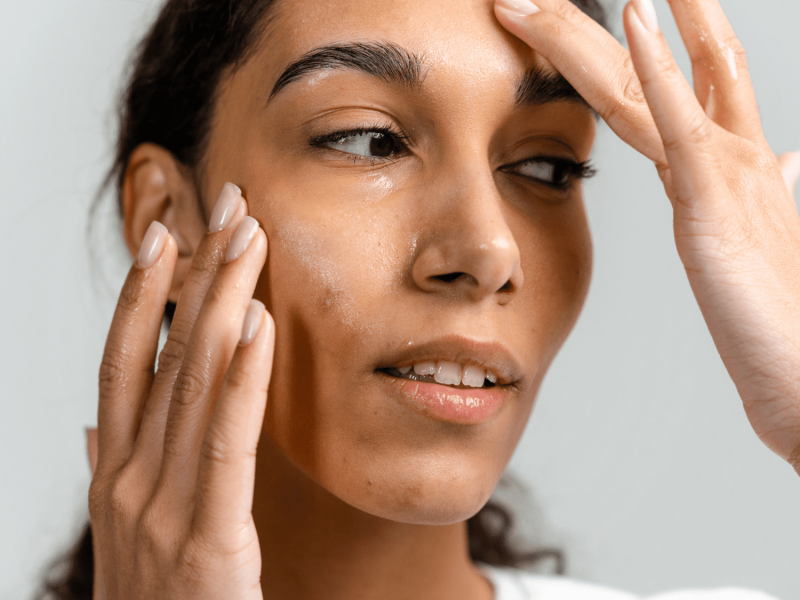Close

If your skin type is dry, then a skincare routine tailored to your specific needs will be the first recommendation that dermatologists give. Usually, that involves a lineup of emollient or humectant lotions, creams, and moisturizers formulated to attract and hold hyrdration, as well as promote the function of the skin’s natural moisture barrier. However, if you’re anything like us, you may find yourself in a situation where your dry skin requires hydration ASAP, and you’re fresh out of your favorite products.
Don’t fret, though; there are so many nourishing products and ingredients out there—and you probably already own a few of them. To assist, we asked board-certified dermatologists Paul Jarrod Frank, MD, Kristina Goldenberg, MD, and celebrity esthetician Joanna Vargas what products can be used to moisturize in a pinch.
Keep reading to discover the best lotion and moisturizer alternatives.
Oils and Butters Like Shea Butter
If feeling greasy is what turns you off about cream moisturizer, experts suggest using oil as a means of locking in hydration. There seems to be a common misconception that oils will leave you feeling like you just ran a marathon in 90-degree weather. However, this notion is simply not true. In fact, there are many oils that are light, easily absorbed, non-comedogenic, and great for daily use.
“The secret is using natural oils,” says Goldenberg. “Shea butter is one of my favorites. It gives the skin lasting moisture. As someone with dry, sensitive skin, I do not have to worry about an allergy since this is a very gentle product.” Frank says oils are even better than creams at locking in hydration. “Water dries the skin, but oils and ointments are the most hydrating,” he adds. “Lotions go on easy but still don’t hydrate as well as an oil.”
Serums
For a lighter option, Vargas says serums will get the job done, especially if they’re blended with fatty oils. She says, “Serums are great for hydration if they contain good fats like argan, avocado, or olive oil. Oils provide omega-3 fatty acids to keep the lipid layer moist while serving as anti-inflammatories. Also, my own retinol, Super Nova Serum helps to hydrate while stimulating collagen production.”
Moisturizing Masks
Vargas is also a big fan of using sheet masks to nourish the skin—a pricier option for everyday use but perfect for quick and easy application. Masks might also be better for acne-prone skin because they don’t typically contain oils. “I tend to do a sheet mask every night before bed and always use them on the plane,” Vargas explains. “My sheet masks are loaded with great serum, and I feel like it’s enough to treat the whole face, neck, and chest.”
Honey
Goldenberg reveals that her pick for a one-stop moisturizing product would be honey. “Honey is the most versatile. It provides moisture, it has antibacterial properties, and it also has antioxidants to help with anti-aging,” she explains. “For those reasons, honey is my favorite.”
Colloidal Oatmeal
Speaking of grocery store heavyweights, colloidal oatmeal can be a godsend for any dry skin woes. With natural anti-inflammatory and emollient properties, it turns out the humble ingredient is just as calming for cracked, irritated, or sensitized skin as it is for the soul. It’s even lauded as a savior for helping eczematic skin. Colloidal oatmeal can be found in many skincare products from serums and oils to, yes, lotions and moisturizers. You can also add it directly to a face bath or mix it into a homemade mask, which pairs beautifully with honey.
Aquaphor or Vaseline
When asked what his lone choice would be, Frank recommends a drugstore staple: Aquaphor. He shares, “I always recommend using Aquaphor often, as it provides an extra layer of protection for your skin. It’s especially great in the winter and helps protect skin from the wind.” A petrolatum derivative, Aquaphor is an occlusive that locks in moisture and prevents transepidermal water loss by creating a seal on top of the skin. Because of this, it’s best to apply the product as your final skincare step, as it will create a barrier between the skin and anything layered over the top.
DIY Avocado Moisturizer
Another great option is to concoct your own mask or hydrating cleanser—a method that Goldenberg stands firmly behind. “It’s easy to create do-it-yourself masks and cleansers at home that will be very hydrating,” she says. “Some of my favorite ingredients to use are coconut oil, avocado, and honey. Don’t forget the turmeric if you want to add a little bit of anti-aging to the mix.”
